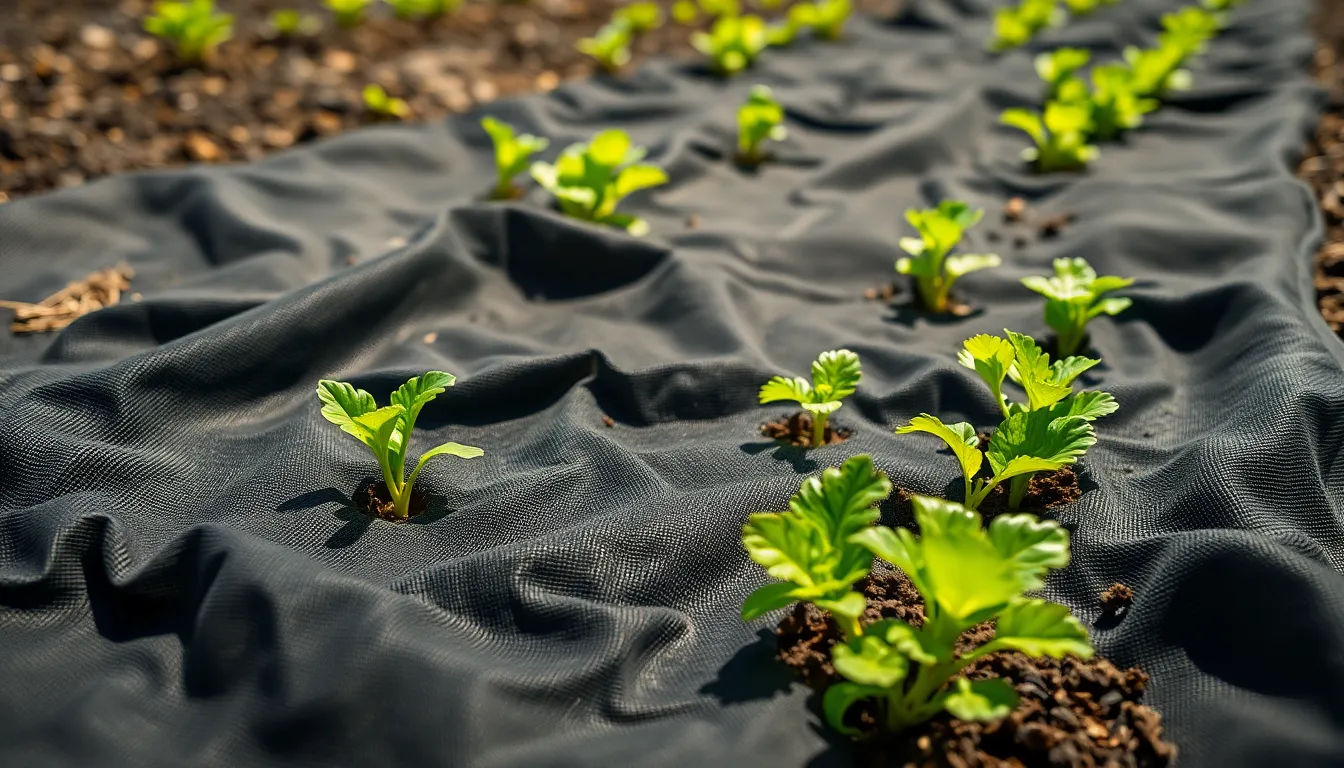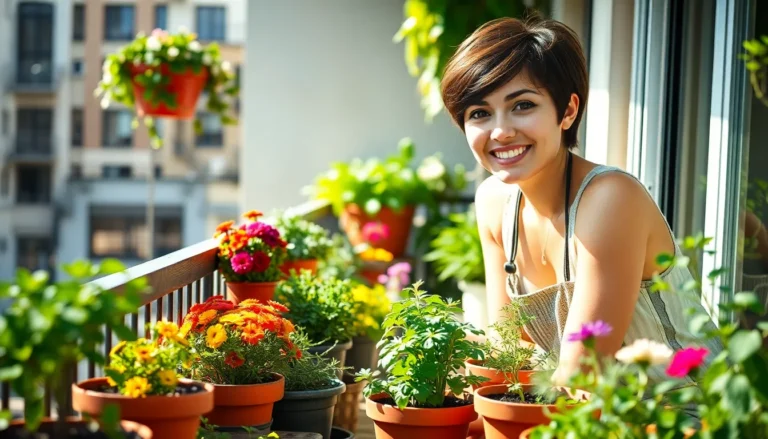In the world of gardening, there’s a secret weapon that often gets overlooked—gardening fabric. This magical material is like a superhero cape for your plants, ready to battle weeds while letting water and nutrients flow freely. Imagine a garden where the only thing sprouting is your beautiful flora, not those pesky weeds trying to steal the spotlight.
Gardening fabric isn’t just a practical choice; it’s a game-changer. It’s lightweight, durable, and ready to tackle the toughest gardening challenges. Whether you’re a seasoned green thumb or just starting out, using this fabric can save you time, effort, and a few choice words when those weeds come creeping back. So why not give your garden the protection it deserves and let your plants thrive?
Gardening Fabric
Gardening fabric refers to a specialized material designed for various landscaping and gardening applications. This fabric serves as a barrier against weeds while permitting essential water and nutrients to penetrate, promoting healthy plant growth. Made from lightweight yet durable materials, gardening fabric can withstand environmental elements like sunlight and moisture.
Commonly known as landscape fabric or weed barrier, gardening fabric provides efficient weed control, reducing the need for chemical herbicides. Many gardeners favor it for its ability to enhance soil health by allowing beneficial microorganisms to thrive. Additionally, such fabric minimizes soil erosion, particularly in sloped gardens or areas with heavy rainfall.
Various types of gardening fabric exist to meet different gardening needs. Woven fabrics offer excellent durability and resistance to tearing, while non-woven options provide good breathability. Thickness also varies, with heavier fabrics suitable for long-term use and lighter versions ideal for seasonal gardens.
Installing gardening fabric is simple. Gardeners can lay it directly on the soil after preparing their garden beds, cutting holes for plants as needed. This kind of preparation significantly reduces time spent on weeding throughout the growing season.
Choose gardening fabric that fits specific gardening goals. A fabric suited for vegetable gardens may differ from one intended for ornamental beds. The right fabric not only fosters healthy growth but also simplifies maintenance.
Benefits of Gardening Fabric

Gardening fabric serves multiple purposes critical for effective gardening. This protective material ensures healthier plant growth by addressing various environmental concerns.
Weed Suppression
Weed suppression represents one of the main advantages of gardening fabric. This barrier prevents weeds from accessing sunlight, essential for their growth. By blocking these unwanted plants, gardening fabric significantly reduces the need for manual weeding efforts. Gardeners often find that using this fabric decreases competition for nutrients among plants. Furthermore, a well-installed weed barrier enhances the efficiency of mulch applications, providing an additional layer of protection.
Moisture Retention
Moisture retention proves another crucial benefit. Gardening fabric enables rainwater to penetrate while minimizing evaporation. This moisture sustainability helps maintain consistent soil hydration for plants. Applications of gardening fabric facilitate effective water usage, leading to reduced irrigation frequency. Maintaining proper moisture levels directly contributes to plant health and growth, promoting lush greenery in gardens.
Soil Temperature Regulation
Soil temperature regulation adds to the benefits of gardening fabric. This material helps stabilize soil temperatures by insulating the ground. Gardeners experience fewer temperature fluctuations, creating a more hospitable environment for root systems. As a result, plants may establish themselves more effectively. Proper temperature regulation supports overall plant resilience, allowing gardens to thrive in varied weather conditions.
Types of Gardening Fabric
Different types of gardening fabric serve specific purposes and cater to various gardening needs. Understanding these fabrics aids in making informed choices.
Landscape Fabric
Landscape fabric, also known as weed barrier fabric, prevents weed growth while allowing air, water, and nutrients to penetrate the soil. Woven landscape fabric provides durability and strength, making it suitable for perennial gardens and flower beds. Non-woven options offer flexibility and are ideal for temporary applications. Many gardeners appreciate how landscape fabric supports soil health and promotes plant growth by suppressing unwanted vegetation. Utilizing this fabric enhances efficiency, reducing the time spent on manual weeding.
Row Cover Fabric
Row cover fabric protects plants from cold temperatures, pests, and harsh weather. This lightweight, translucent material allows sunlight and moisture to reach the crops while providing an insulation layer. Many gardeners use row covers to extend the growing season for delicate plants and seedlings. Different thicknesses are available, catering to various climates and growing conditions. Implementing row cover fabric results in healthier plants and increased yields. It contributes significantly to sustainable gardening practices by minimizing the need for chemical pest control.
Garden Mulch Fabric
Garden mulch fabric offers a solution for moisture retention and weed suppression while enhancing soil quality. Crafted from biodegradable materials, this fabric breaks down slowly, enriching the soil as it decomposes. Many gardeners opt for mulch fabric to create a natural barrier, reducing the frequency of weeding and maintaining consistent soil temperatures. Various colors and textures are available to match landscaping preferences and garden styles. Utilizing garden mulch fabric not only promotes healthy growth but also contributes to environmentally friendly practices in gardening.
How to Use Gardening Fabric
Applying gardening fabric correctly enhances its effectiveness in weed suppression and soil health. Understanding the best practices for installation and maintenance leads to better gardening outcomes.
Installation Tips
Begin by preparing the garden area for optimal results. Clear away debris, rocks, and existing weeds before laying down the fabric. Cut the fabric to size to fit the designated area. Overlap edges by 6 inches to prevent weed growth at seams. Place the fabric over the soil, securing it with landscape staples every 2 feet. Create slits for planting if necessary, ensuring the fabric remains taut. Water penetration occurs easily, so avoid excessive digging or disruption after installation. Consider using a layer of mulch on top to provide additional weight and further suppress weeds.
Maintenance Best Practices
Regularly inspect the gardening fabric to ensure it remains intact. Check for any tears or areas where weeds may be breaking through. Remove debris, leaves, or grass that accumulate on top of the fabric, as this can promote pest activity. Adjust the fabric as needed during seasonal changes to address shifting soil or plant growth. Maintain moisture levels by monitoring irrigation needs, especially in dry conditions. Replace or repair damaged sections promptly to maintain the effectiveness of weed suppression. Keeping the fabric clean and well-maintained contributes to long-lasting benefits in gardening practices.
Conclusion
Gardening fabric proves to be a game changer for anyone looking to enhance their gardening efforts. Its ability to suppress weeds retain moisture and regulate soil temperature makes it an invaluable resource. By choosing the right type of fabric and following proper installation techniques gardeners can significantly improve their plant health and overall garden productivity.
With its lightweight and durable nature gardening fabric caters to both novice and experienced gardeners alike. Embracing this tool not only simplifies gardening tasks but also promotes sustainable practices that lead to thriving gardens. Investing in gardening fabric is a step toward a more efficient and enjoyable gardening experience.




